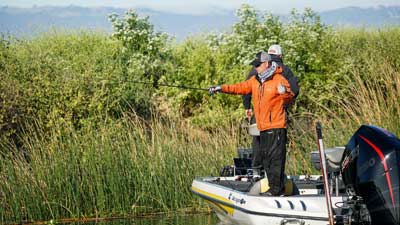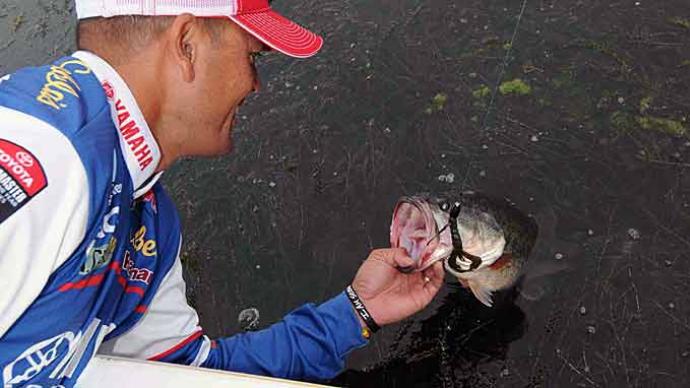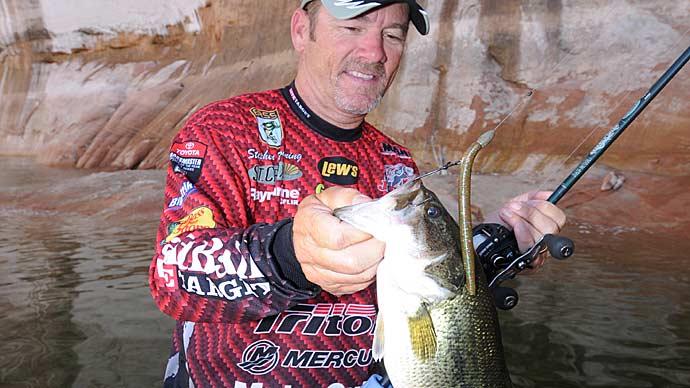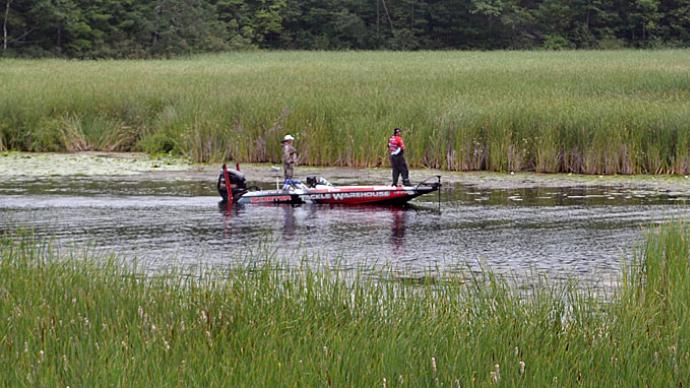
In the world of bass fishing, many different techniques will catch bass. Each has a time and place, and they all fit different situations and conditions. When fishing, heavy cover, flipping, pitching, and punching are must-know techniques. They excel when fishing around docks, grass, brush, and other cover and have a knack for catching giant bass.
Here's a rundown of the three techniques and the best places to use them.
Pitching
Of the three, pitching is one of the most commonly used, and many anglers call it "flipping" when they are actually pitching. It's done by sweeping the rod forward, with the line and bait moving just above the surface in a pendulum motion as the bait enters the water. It's excellent for hidden spots, placing your bait tightly into holes in the brush, grass, lily pads, and other cover. Pitching is also great for getting your lure under overhanging trees and below docks.
Pitching excels for fishing around a variety of cover, and some of the most common baits are jigs or Texas-rigged soft plastics. The best rods, generally a heavy or extra-heavy power and longer than 7 feet, are the most popular choices. Some rods that are even longer will make it easy to get more distance with your presentation.
Choose your line based on the cover. Fluorocarbon lines that are a minimum of 15-pound test are essential for fishing around abrasive cover and assist with pulling big fish away after hooking them. For example, a 17, 20, or 22-pound Seaguar fluorocarbon is excellent for wood cover and fishing around grass. In addition, 50 or 65-pound Seaguar TactX braid is a great option, and the braid helps slice through vegetation, making it easier to land fish.
Practice makes perfect with the pitching technique, as accuracy and reducing sound are two of the most critical things for getting bites. A soft entry into the water is less likely to spook fish, and putting your bait into areas that others overlook (or can't get to) will also generate more bites. One of the best ways to practice is to set up cups or cans in your backyard or even inside your house and make repeated practice pitches to get the motion down. It's a great way to use some downtime at home to catch more bass in the future.
Flipping

The late California pro angler Dee Thomas made the original flipping technique famous. Initially, he used very long rods to drop his bait into the tules (reeds) to get to fish buried deep in the cover on the California Delta with a technique first called "tule dipping." He took the technique outside of California in the 1970s and took the tournament scene by storm as he won multiple events and changed bass fishing forever. The "flipping stick" rod style that still exists today was born, and longer rods with heavy power are still used by anglers pitching, flipping, and punching today.
The beauty of the technique is that a bait can enter tight areas with extreme silence. It's also a very efficient technique as you can make repeated presentations and can cover every inch of an area. It's done by holding the line and placing a bait into cover with the rod in the other hand. The motion and letting go of the line let the bait move forward, and when the line is released, the bait will fall to the bottom.

Like pitching, soft plastics and jigs dominate with the flipping technique. Also, like pitching, longer rods and heavy lines are the best choices because of the thick cover. It can be done around standing vegetation like reeds and cattails but also works well for fishing around standing trees and other wood cover.
Punching
The newest of the three, punching, involves a heavy weight that "punches" through heavy cover, nearly always thick grass. Tungsten weights weighing over an ounce make it possible to get through the vegetation and present a bait to a fish that would not see a bait if not for this technique. Soft plastics dominate with punching as they are streamlined and easy to get through vegetation. The best baits are those without many appendages, such as beaver-style baits.
Anything matted on the surface is fair game for punching, but vegetation is the most common place to do it. Certain types of vegetation grow to the surface in the warmer months and form a mat, and these can be ideal places to punch your bait through the mat created on the surface. For example, hyacinths are found in many parts of the country and can be great places to use the technique. "Trash mats" are another common place to do it, and the term applies to chopped grass, leaves, and any other material that builds up on the surface, often blown into areas by the wind or current.

A stout rod and braided line are critical when punching because of the heavy cover and great chance of hooking a large bass. A braided line of at least 50-pound test should be mandatory, and most anglers opt for 65-pound test or more. With the technique's popularity, many straight shank hooks work well for the method. This hook style is a good choice because of how well it hooks fish deep in the cover.
Tungsten weights weighing 1, 1-1/2, or 2-ounce make it easy to penetrate the matted cover quickly. Many bites will come during the initial descent, so pay close attention as the bait first crashes through the mat. Then, try lifting and dropping the rod to entice the fish. If that doesn't work, bring it back and repeat the process.
Flipping, pitching, and punching are techniques that every bass angler should know. They work well for reaching hard-to-reach bass and can get your bait to bass that are not expecting lures, generating reaction strikes from hiding bass. Practice makes perfect with all three techniques, and the more proficient you can be with placing your bait, the better.
BassResource may receive a portion of revenues if you make a purchase using a link above.




